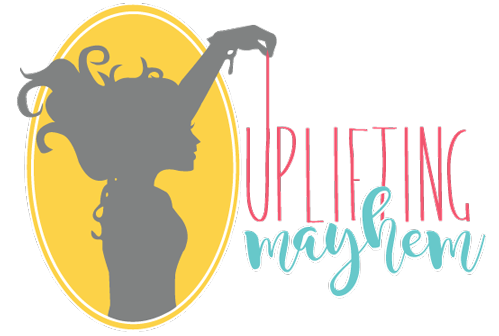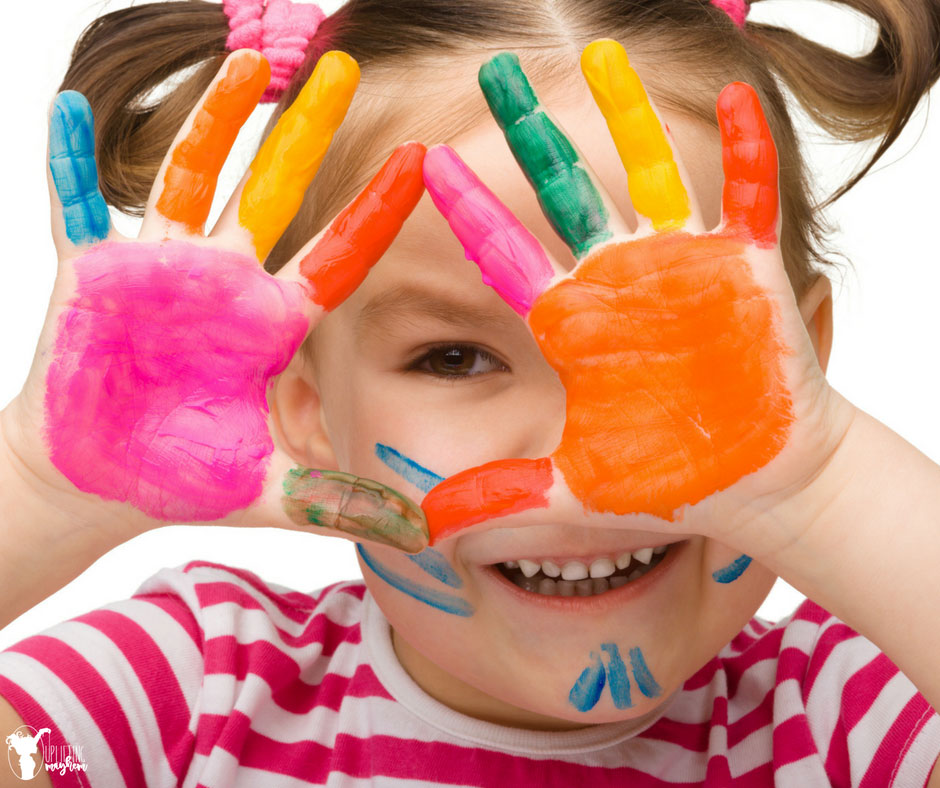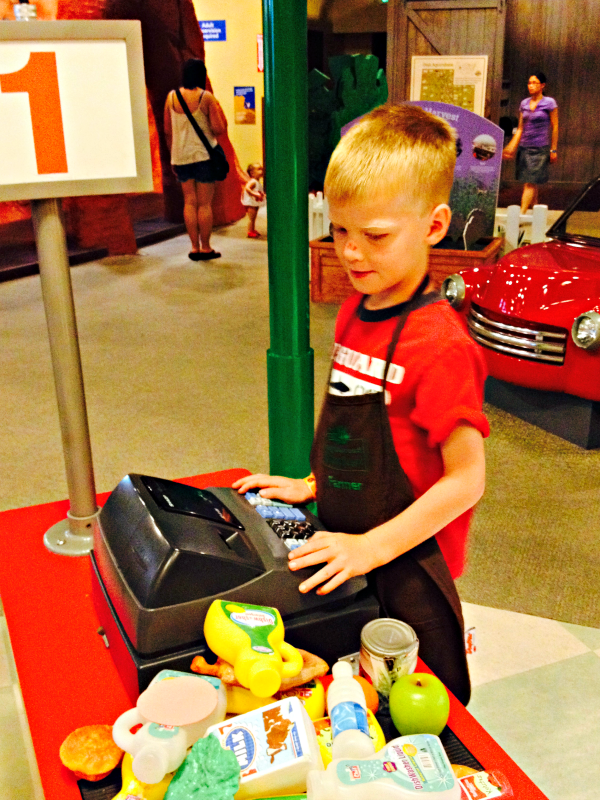Are you teaching your preschooler at home?? Are you wondering whether to pay for preschool or teach them at home? Both are great options. I was a preschool teacher for 9 years. I loved every minute of it.
When I started having my own children, I decided my plate was full enough with my own little kids and stopped teaching. I still look back on those years though and I’m so grateful for everything I learned as it has helped in raising my own children.
I want to share 10 tips I used myself as a teacher and now as a parent for teaching your preschooler at home. Enjoy!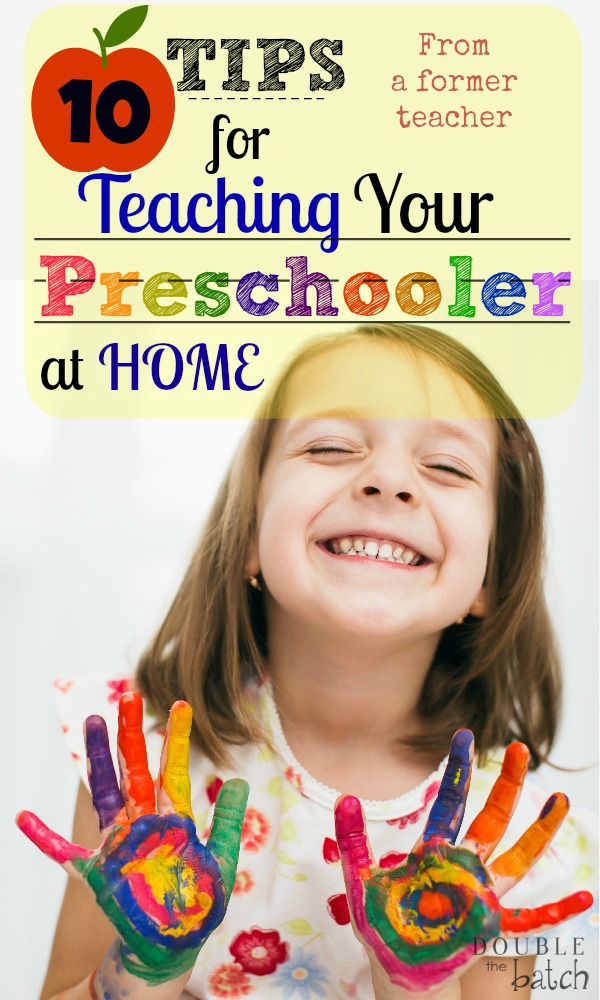
1. Emotional development.
I put this first because I feel like it is the most important. Teach your child the different emotions by demonstrating good examples of each one so they can learn the difference. Use every opportunity in real life. For example, when they are sad, say, “I see you are feeling sad right now” or “Are you happy?”
It’s important that they learn what all the emotions are and that it’s healthy to feel all of them at different times. Almost every behavioral issue that arose in all the classes I taught had an emotional root. Children who had learned to deal with their emotions in a healthy way, had an easier time adjusting in school.
If your chid is angry all the time, take a look at their environment and the examples they have to learn from. Give them more opportunities to feel love and express it. The same applies to all emotions. I have a daughter who is barely old enough to go to kindergarten this year but I am holding her back mainly because I think she needs another year to work on her emotions.
She is a middle child and came right after my son who was a stressful little toddler. I really feel like she just didn’t get the attention and love from me that she so desperately needed because I was always so worried and stressed about her older brother.
This is my year to spend some one on one with her and give her some TLC. If you want to study up more, or need some good ideas I highly recommend this book. If you just want some fun books to read to them to help them understand different emotions, here are 3 of my favorites:
How Are You Peeling? (my students would ask me to read this one over and over!)
2. Physical Development.
30 years ago this wasn’t as much of a concern because children naturally spent more time outside playing, climbing, running and jumping. Today, regardless of our best efforts, children spend more time inside and more time in their seats at school.
Make a conscious effort to teach your child how to skip, hop, do the crab walk, balance, run, dance, etc. In the preschool where I worked we were expected to teach all of our students these skills. It seems like a silly thing and most parents think those skills just come naturally but sometimes they don’t.
My favorite way to teach my class these movements? Turn on some fun music and dance, and throw in a new skill each time. Trust me, they will NEVER know, they will just think you’re the most AWESOME parent ever! Want ideas for music? Anything fun and uplifting. I loved using this album in my classroom. (my students always loved The Freeze Dance and Animal Action) That brings me to my absolute favorite thing to use in teaching preschoolers:
3. Music.
Anyone who knew me as a teacher, knew how much I loved using music. You can connect to just about any child with music. I used it to teach emotions, I used it to teach letters, to teach math…EVERYTHING! We would play music for clean up time and we sang a different song at snack time every day.
Music is so powerful. Children remember the words to songs faster than anything else. If your kids have seen Disney’s Frozen or any other Disney movie for that matter, you know exactly what I’m talking about! If you’re having a hard time teaching your kids a concept or getting them to do something, apply some music and you will be amazed at how much more eager they will be.
I remember once, when my mom was having the hardest time rounding us all up for family prayer at the end of day. She started playing this song every night instead. When we heard the music we new it was time to meet in the living room and we had better be there before the song ended. It was funner for us and saved her voice and her sanity. Here are some fun albums we like at our house:
Greg and Steve Playing Favorites, Greg and Steve Big Fun, Greg and Steve Kids in Action.
Yummy Yummy (kids absolute favorite! I had to buy another cd, this one got so worn out!)
The Wiggles Sampler, (this one is FREE!) Hot Potatoes! The Best of the Wiggles.
Skip Count Kid (ok, don’t be fooled by the cover, this album is AWESOME for teaching kids to skip count! My brother learned all his times tables from these songs! He’s now a parent himself, and he can still sing these songs from memory. Suitable for preschool-6th grade, although you might want to make sure your child can count to 100 first:-)
4. Writing skills.
One of the first things we would do in our classroom was have the children trace their names. We would use handwriting paper, write their name with a highlighter, then have them trace it. Once they had mastered that, we would have them write their name by themselves, then their last name, then numbers, other letters, etc.
Worked like a charm. Make sure your child has a nice thick pencil for their small hands to grasp and that they are holding their pencil like this:
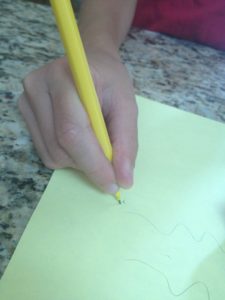
You could also use a dry erase board like this or write their name and any other letters or numbers you want them to learn on a paper. Put that paper into a dry erase sleeve and let them use a dry erase marker to trace it and then reuse it the next day. Learning to write, will also help them to learn how to read faster. The opposite is also true. It’s a great idea to teach a child how to write a letter the same day they are learning that letter and it’s sound.
Be very patient and praise often. Every child learns at their own pace. I only have one memory from when I was in preschool. Unfortunately it was my teacher getting upset at me because I wasn’t writing a letter correctly. Sad, huh? Create positive and fun memories with your child!
Here are some more great books and activities for practicing writing:
Handwriting workbook for letters, Board Dudes Dry Erase book, Before I write
5. Letters and reading.
Let me start by getting something off my chest. Why does almost every product on the market that teaches children letters use CAPITOLS? Seriously? Think about it, when you read a book, what percentage of the letters are capitalized? I can’t tell you how many kids started the school year knowing only capitol letters.
My advice would be to teach your child lower case letters first. Capitols are easy to learn. If they learn the lower case letters, the capitols will come easy after that. It’s also so hard to find a good app that doesn’t use capitols. I’ve found a great one which I will share in my next post.
Teach your child one letter at a time, and teach them the sound it makes first. We always started with m, then a, then s and f and t. Then they can spell am, sam, at, fat, mat. As soon as they know enough letters to form a word, start teaching them to put the sounds together to read that word. Make it fun. Make nonsense words. It doesn’t matter, as long as they are learning how to put the sounds together.
Do you love using technology to teach your children? Read this post for great ways to teach your child to read using the best apps and websites.
Here are some great resources I love:
Letter Factory (love!!), Letter Bingo, Hooked on Phonics workbook, magnetic lower case letters, Melissa and Doug wooden magnets
6. Numbers
Your child will learn how to count by listening to YOU count constantly. You can start when they are very little. When I change my babies diapers, I count snaps, buttons, how many arms, legs, etc. You can count how many bites during feeding time, whenever!
When you go to the grocery store, point out how much items cost and then ask them the next time, “How much is that?” “What number is that?’ Make it a part of normal life, but don’t stress them out about it. After all, no one said your kid needed to know algebra by the age of 3, right?
I learned to just teach and love during these precious early years, don’t EXPECT. For example, just because you’re neighbor’s kid knows all their numbers and simple addition by age 4, doesn’t mean you should expect your kid to. Children crave love and attention. They just want to know you think they are awesome in everything they do, no matter what the pace.
Here are some great numbers games and workbooks:
Melissa and Doug magnets, numbers puzzle, Learning Resources pie (I LOVE ALL of the Learning Resources products!! They are high quality and made very well)
7. Shapes and Colors
Once again, these are more easily learned at home by just pointing them out and teaching throughout your normal routine. I will tell you that the hardest 2 shapes for most preschoolers to learn are the octagon (8 sides) and the hexagon (6 sides).
A stop sign is an octagon, so that one could easily be learned by pointing at it while driving. I liked to cut out all the shapes, (circle, triangle, square, rectangle, oval, diamond, octagon, hexagon, pentagon) color them each a different color, and draw silly faces on them with a sharpie.
It made it easier for them to memorize and funner too. Ask them to point to as many things as they can in the room that are that shape. You could even play I spy. Here are some other links to games that are fun for teaching shapes and colors:
Colors an Shapes Flashcards, Lace and Trace Shapes, Shapes Bean Bags, Color & Shape Bingo
8. Fine Motor Skills.
We always tried to have activities on the tables when our students first arrived, to practice their small motor skills. Ok, for those of you who might be wondering what fine motor skills are, here is a definition from wikipedia,
“Fine motor skill is the coordination of small muscle movements which occur in body parts such as the fingers, usually in coordination with the eyes. In relation to motor skills of hands and fingers, the term dexterity is commonly used.”
Also, here’s a great link if you want to learn more: https://www.babycenter.com/0_how-to-help-your-toddler-develop-fine-motor-skills_11549.bc
There are SO many activities you can do with your child to teach fine motor skills, from picking up their cheerios as a baby to now learning how to hold a pencil, or stacking blocks to build a tower. I am also adding links to my favorite toys and activities that I have used over the years.
Stackers, Counting Bears, Stacking Cubes, Lacing Cards, Melissa & Doug Puzzles
9. Social Interaction and Playtime
A major portion of preschool is playtime. A lot of parents would ask me why we gave the kids so long to play. Interacting with other children their age, learning how to share, learning how to lead, how to follow, how to be kind, are learned through playing with other children.
A child can be absolutely brilliant academically, but if they can’t interact with other kids their own age in a healthy way, it can be detrimental to their learning environment.
I once had a 3 yr old boy added to my 4 yr old preschool class. His parents felt he was too smart for the 3 yr old class. I noticed very quickly that they were right about one thing, he was brilliant! I could write ANY word on the board, and later in the day he could write it perfectly from memory.
He memorized songs almost instantly and was a numbers whiz. I can honestly say he was probably the smartest kid I ever met. There was a huge problem, though, he could not interact with the other children, nor did he have any desire to try. The parents insisted that he be moved to kindergarten (he was 3!) because of his brilliance and (much to my dismay) the principal allowed it.
He was a young principle and I don’t think he thought that one through very well. It ended up being a huge mistake but by the time they realized it, they felt it was too late to then move him back down. Never underestimate how important social interaction is! If your child is having a hard time in this area, try to step in and teach them positive ways to interact with others. If it is still a huge concern, talk to your pediatrician.
10. HAVE FUN!
I think I add this to all my posts, but it’s because it’s the tip I have to constantly remind myself of. Have fun in everything you do. You’re little children are only at home with you a short time before they start going to school full time (unless you are one of those awesome brave parents who homeschool. Hat’s off to you too!)
You want them to start school with a love for learning and joy in their sweet little hearts. Everyone loves to learn new things if it’s fun! So, relax, take it one step at a time and have fun!
Are you thinking of sending your child to a preschool outside your home? Read my post, “6 Things to Look for in a Preschool.”
